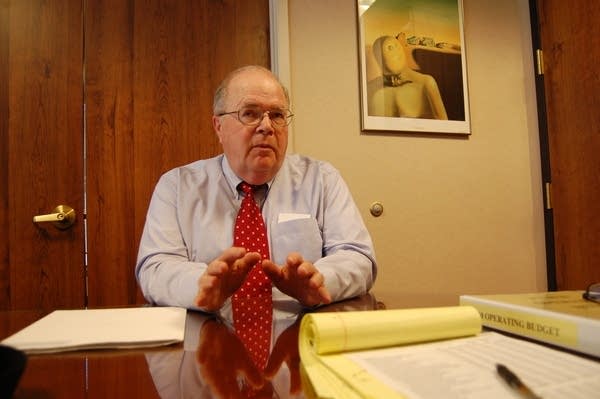U of M regents weigh privacy vs. public access in presidential search
Go Deeper.
Create an account or log in to save stories.
Like this?
Thanks for liking this story! We have added it to a list of your favorite stories.

As the search unfolds for a new University of Minnesota president, it can be hard to figure out how deep the candidate pool is. And the Board of Regents may not make it any easier.
Robert Bruininks will retire at the end of the school year, and the regents hope to name a successor by late fall or early winter.
The board could publicly name several finalists, or it could name just one.
That concerns faculty who want input in the final decision. And it shows the struggle universities face in balancing the public's right to know with protecting the identities of candidates for a top job.
Turn Up Your Support
MPR News helps you turn down the noise and build shared understanding. Turn up your support for this public resource and keep trusted journalism accessible to all.
Clyde Allen, chair of the U of M Board of Regents, says the final stages of the national search for the U's top post could play out like this: Final candidates would be named, then brought to campus where they'd face a number of very public job interviews with students, faculty and staff.
That's if there are several strong finalists for the job. But that process could also feature just a single finalist.
"Who did not apply because she or he was concerned that their name was going to be made public."
"If we find one person who is head and shoulders above everyone else, there is the possibility of naming one," said Allen.
When the U hired Robert Bruininks in 2002, it kept the finalists names' secret. Bruininks, who was the interim president at the time, wasn't one of the finalists chosen by a search advisory committee.
Several Minnesota news outlets filed a lawsuit over the issue. In 2004 the Minnesota Supreme Court ruled that state law requires the U to release the names of finalists in a presidential search.
So if the U's Board of Regents names only one finalist at the tail end of the current search, is that an effort to get around the law?
Regent Allen says no.
"It is in no way an attempt to get away from naming the finalists. It is simply a function of how strong the candidates are," he said.
Some faculty members hope the regents don't whittle down the list of finalists to only one, before the public gets a look at the strongest contenders.
"In order for everyone else to be confident that that one person truly is superior, it's necessary to hear from a range of candidates who differ from each other," said Eva Von Dassow, a professor in the college of liberal arts.

Colleges, especially large state-run universities like the U of M, engage in a balancing act when they look for a new president.
Sunshine laws force them to open their doors and let the public see who's being interviewed as a finalist. But colleges also want to protect the names of those top candidates until the very end.
For anyone in the workplace, it's easy to understand why. If you're interested in a new opportunity, you don't want everyone at your current job to know you're looking around.
"With college presidents, since they embody the face of an institution, it is almost intensified for those folks," said Jan Asnicar, who handles the higher education division at EFL Associates, an executive search firm in Kansas City, Kansas.
Maureen Reed, a former member of the U's Board of Regents, worries that some top-quality candidates never come forward because they're worried about that spotlight.
Reed chaired the board in 2002 when Bruininks was hired for the top job. During the search, Reed says, she wanted to keep the names of the finalists private. And she wonders what the prospect of making names public in the current search has done to the process.
"What we don't know, and what we will never know, is who did not apply," said Reed, "because she or he was concerned that their name was going to be made public."
Reed says the public has a right to know who colleges are considering to be their next president, but in her opinion that shouldn't interfere with a school's duty to find the best candidates for the job.
The University of Minnesota isn't the only state institution involved in the public search for a new leader.
The Minnesota State Colleges and Universities system is looking for a chancellor to replace James McCormick, who plans to retire next July. MnSCU officials say they expect to publicly name three to five finalists for that job by early next year.




